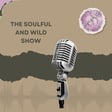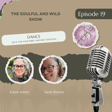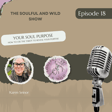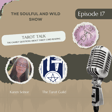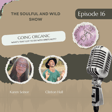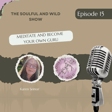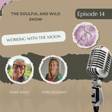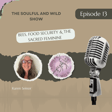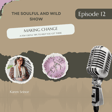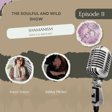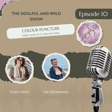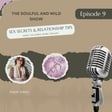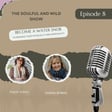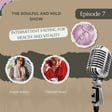Introduction to Marie Nicole and Her Work
00:00:15
Speaker
Well, welcome everybody. I have Marie Nicole. Marie, say your, Marie Nicole, please say your name for me. It's Monier. A beautiful French sounding name. It's so gorgeous. It matches you perfectly, really. It's just my pronunciation that's a bit like, oh, I was nervous. Now, Marie Nicole,
00:00:38
Speaker
I have known for a little while now. She is an emotional coach and has many, many skills. And the reason that I have invited her for this podcast today is I've just finished reading her book and I am blown away. I just absolutely love it. And so I've invited her here today to talk about
00:01:02
Speaker
her book and the contents of that to some degree to give us a bit of an idea. I mean hearing your story which I had not known was really great and just the whole idea of what you wear here and how that matters tell us what you can.
The Empower Dressing Guidebook: Self-Acceptance and Clothing Choices
00:01:22
Speaker
Okay that's a massive open-ended question.
00:01:27
Speaker
No, look, it all intertwines. And so that's where the layers of complexity over a lifetime have suddenly, sorry, I hit my mic, have suddenly meshed in together. So I have been a coach for a few years, certified officially, but have been advising people for many years, like I've mentored people in their own business, establishing their own business.
00:01:55
Speaker
And as a creative, so I was a maker and designer, originally a photographer and had my own business for nearly 10 years. So I've always been in these creative industries and having to do business to create my own path. And so I mentored new people to business in that. But my coaching, I actually went into more embodiment coaching and got certification in Dharma coaching, which is finding your soul's purpose.
00:02:25
Speaker
because I am definitely not a cookie cutter person. And so I don't fit any molds. And even the fact that I make and designed clothing and make clothing, that was never my intention. My mum was a seamstress and I grew up sewing, but I really did think photography would be my lifetime career. And then after having my second child, I just decided to
00:02:55
Speaker
do a job that I could actually do with children in tow. And that's where I brought back the making as my full-time work. With children, I say full-time, I've always blended work with children being around. So yeah, so embodiment coaching is kind of why the clothing has become so important because I ended up dressing to feel comfortable.
00:03:20
Speaker
in my unique physique, which has always been apparent and the fashion industry never geared clothing towards my physique. So I created my own. I decided from a very young age I would try not to fight myself. I would just embrace it.
From Power Dressing to Authenticity: Marie's Personal Journey
00:03:38
Speaker
And that's really where this guidebook has come about. The Empower Dressing Guidebook is really about us understanding ourselves, working with what we've got. And it's not about
00:03:50
Speaker
just accepting and being laissez, it's actually empowering ourselves to feel a sense of worthiness with what we've got rather than looking at what we don't have. And so that I hope that sums up what it is you are wanting to hear. That's actually beautiful. Thank you so much. I mean, when I first, you know,
00:04:14
Speaker
looked at your book you know just from the front and it brought to my mind and of course I know this is completely not you because you are absolutely your own unique self and that's one of the reasons why I love you.
00:04:29
Speaker
But it brought to my mind an event or situation when I was first started in my business. I used to run the Albury Hypnotherapy Clinic. I did that for about 10 years and I was a driven mad woman working crazy hours and stuff. And I wanted success. And so I went and did a public speaking course because I was rubbish at that. And I met these women
00:04:57
Speaker
who were very slick, actually, and very successful. Little did I know that they were backed financially by other people. It wasn't so much their own full creation. But I was caught up in this. I needed to be something that I wasn't in order to be successful.
00:05:23
Speaker
And that is absolutely not what you are about in any way, shape or form. Not now. But I've been down that path. Yeah. So, you know, in in the book, I share the story of when I was a photographer and I was wearing I was wearing a garment that was I would probably say practical, but I felt powerful. I wore a lot of black. I mean, for me, the black was
00:05:51
Speaker
not so much a power over. It was because I didn't want to reflect color onto like the bride's garment when I was photographing it and things like that. But I would wear very sleek. They were actually corporate brands that I was wearing and it was mostly Q design was my brand of choice, which I used to wear suits. When I first got my job, first job out of high school, I was an accounts clerk for a couple of years and I wore suits.
00:06:20
Speaker
in that job. And that just is not me at all now. Even now when I've presented business workshops, I still wear things that are flowy and effortless. But I was in that garment and I was pregnant with my first son and my breast expanded because I was breastfeeding and I had to cut the thing off. And I was just like, this is so uncomfortable on so many levels.
00:06:47
Speaker
But I felt strong. My journey from a young age, I actually wanted to be a lawyer at first. I was very argumentative as a child. I was like, I'm going to stand up for what's right. And then I did my placement in law firm in Brisbane at the time. I was in my teenage years and I was
00:07:10
Speaker
covering the biggest case that there was in Britain at the time, it was so damn boring. And the office work just was, you know, not that the unnatural environment, there was so much about it that I didn't like that that's why I went into photography, which I was passionate about, that I just, you know, had that as a side gig. But I still had that power dressing as what I really stepped into until I had my first son. And so he
00:07:40
Speaker
is 22 now. So for the first probably 10 years of my, when I was 27 when I had him. So I was really someone who saw that powerful dressing and even high collars and tight and everything that just made us women more masculine. And so I'd really stepped into that. And then when I had him, I started to wear softer clothing and colors and
00:08:07
Speaker
And I just it was weird. I didn't expect that to come out. What's this about? Motherhood is literally softening me in so many ways. And yeah, that's when I started to realize that I actually needed to feel comfortable and empowered, not powerful and embrace more of the feminine side.
Inner Essence and Authentic Expression Post-Marriage
00:08:28
Speaker
It still took many years to break out of the masculine, go get a person that I was. But now I really have softened in, I mean, in the late 40s now, I've softened right into what actually serves rather than trying to be something I'm not. Yeah, that's exhausting. It is actually, it is exhausting trying to be something rather than just dropping into what we really are.
00:08:58
Speaker
Yeah, absolutely. That's what I love about, you know, what you've written. It's because that just sort of almost captures it. I think, what did you say? Something about the essence. Yeah, our inner essence being our outer expression is, and that has really only been in the last two and a half years that I've connected with that. I mean,
00:09:23
Speaker
I was married for 24 years. I was in a family dynamic where, and not my husband, we were very much an equal party in our relationship and he was very supportive of what I do. But in terms of extended family, I was constantly having to prove myself and prove that my creative profession was worthy.
00:09:46
Speaker
And so when my marriage ended and I was very confused by why, I really had to go within and I really had to connect back with my essence. And then I started to go back over stories over the years that from childhood, even before I was married, that I just realized were my lessons that I needed to learn so I could connect back to my inner essence and allow that to be my outer expression.
00:10:15
Speaker
rather than trying to fit into moulds that I just wasn't designed for. And just realizing that's my role in the collective is not to try. I mean, I've never belonged anywhere. I'm a Mauritian born in Australia to immigrant parents who didn't speak English as their first language, who were uneducated. And I don't say that to put them down. That's just the reality of it. So we were very much a resourceful family and
00:10:45
Speaker
worked with our hands and I was the first person in my family to go to university. So, you know, that was a big shift. So I didn't even belong in my family. You know, I was very different in my family. Still am. And so I just really had to
00:11:00
Speaker
Contemplate why? What's his journey about? Why can't I belong anywhere? And then I lived in, I was born in Melbourne, lived in Brisbane, moved to Sydney, then to the country. And so everywhere I've been, I've just kind of stood out like a sore thumb. There's no hiding. So I really held on to the Dr. Seuss saying of, why fit in when you were born to stand out?
00:11:26
Speaker
that really, yeah, I started latching onto that maybe 15 years ago and started to let go of the fact, especially living here in the country, it's like I'm not meant to be like everyone else and I actually meant to probably give other people permission to be themselves, whatever that looks like, not for them to be like me, that's not what I'm here to convince people of, it's just you be you and I'll be me, it's like
00:11:51
Speaker
Yeah, it's interesting. I live in a in regional New South Wales. So it's very, dare I say it, patriarchal. And, you know, we must all be married and people have known their friends since kindergarten and all that sort of thing. So people who move into this area really struggle to get traction in terms of social interaction. And, you know, I hear that from clients, actually, it's a big thing.
00:12:21
Speaker
And so yeah, that whole thing about fitting in and you know how it is when you move to a new place or even when you travel, once you go through the doors and the airport, suddenly it's wide open and you can, you're in the flow. Yes. Well, that's where, you know, I moved here from the city and I'm also in regional New South Wales and rural it's considered rural.
00:12:50
Speaker
And I opened up a commercial space to actually welcome in all the newcomers. That was exactly what that space was for, to help women who had moved to the area that moved here based on their husband's employment, which was my situation and lost their own employment opportunities, you know, aligning with their creative professional pursuits. And so I fostered a lot of women through that space in building up their own personal empowerment and
00:13:17
Speaker
and feeling like they belong somewhere.
Vibrations of Fabrics: Energy and Empowerment
00:13:20
Speaker
And that was a really, it wasn't just for newcomers, it was based on that. But I had a lot of people who had been living in the area for 30, 40 years that then came in and said they had, it gave them permission to feel like it's okay to be who they are rather than for 40 years thinking they needed to fit into the culture of
00:13:41
Speaker
the space and it's not to it's not to knock the culture, it's just the acceptance of we all have our unique thread to add to the collective tapestry. It's not we're not meant to be the same. Yeah, I like to use the analogy of in wild nature, like the bird who collects a seed and drops a seed is not the one that pollinates the flower. So we all have our part to play in what we need as a collective. So rather than judging each other,
00:14:10
Speaker
Let's embrace the difference and run with that. Exactly. I was fascinated in your, sorry, is it okay if I bounce over to the clothing and things like that?
00:14:30
Speaker
through your book has actually got me motivated and I actually offloaded four dresses yesterday. They have left the building. You speak in there about fabrics and vibrational frequency and I was loving that.
00:14:54
Speaker
So would you be happy to talk about that, you know, the different qualities of fabric, what you think is good? Yeah. Well, when I first started, when I moved out of photography and into artisanal work, I was screen printing. So I didn't want to be making garments for people. That wasn't the intention. I was making tea towels and sethietz.
00:15:15
Speaker
aprons and I was screen printing onto them but then there was so much of that out in the marketplace that I just started then working with old blankets and making instrument cases and things out of old blankets. But I chose, I was very selective when it came to the screen printing and even the fabric that I lined my bags with because I then started working with kangaroo leather still lined in linen. I selected the fabrics based on them being eco-friendly.
00:15:44
Speaker
because I have a big eco-friendly stance on everything that I do. And then I started to think, you know, when I wear linen, I actually feel really good. Like I generally run hot. My constitution is that I run hot and living in Brisbane, I really struggled with humidity.
00:16:01
Speaker
And so the choice of fabrics for me personally to stay cool and was really important that I understood what worked for me. I didn't know about the frequency when I chose those fabrics. I have only in recent years come to understand that. But I also when I started making clothing upon customers request because what I was wearing, they loved and they asked me if they could order it.
00:16:27
Speaker
So I then, when I decided to bring clothing, I just went, you know, I have to focus on the fabrics that make me feel good, which I'm pretty sure are going to make others feel good because linen has a thermal quality regulating aspect to it, which fine merino does too. And so they were my base fabrics. And then I discovered that there's actually a frequency to this and then it makes sense once you hear it because everything is energy and everything has a vibration and even
00:16:56
Speaker
if you have, like they take the frequency of a flower and it actually emits a certain vibration and then a bee is attracted to that vibration and once the bee gets there, the frequency changes. It's like, we can prove all of that, but we have not really looked at, oh, so how does the fabric that I'm wearing affect me? And so when I discovered that polyester actually reads at 10 Hertz, which is pretty low when you think,
00:17:25
Speaker
about the fact that a sick person reads at 15 hertz and organic cotton 110 hertz. So just the difference between wearing organic cotton and polyester is huge but linen and wool read at 5000 hertz. So that's a massive difference and it really started to resonate with me why
00:17:50
Speaker
I would be in people's presence, even in the last two and a half years when I was going through one of the hardest transitions of my life and they'd say, I love your energy. And I'm thinking, oh my goodness, I'm going through this massive life transition. Internally, I feel like I'm falling apart and you're telling me you love my energy upon first meeting me? Imagine if I was feeling good, you wouldn't be able to sit next to me. And then I started to think maybe it's actually not just me. I mean, I do a lot of,
00:18:19
Speaker
work on my energy internally and mentally and physically, spiritually. But then I started to think maybe it's the frequency of the fabric that I'm wearing that is that they're feeling and that's amplifying. And on top of that, it's having that side effect of actually increasing my vibration, my energy, so helping me heal just by what I'm wearing. I was like, right, that's really powerful. So yeah, I just think
00:18:48
Speaker
First thing, you can feel it. You feel the touch of a polyester compared to the touch of a natural fiber and your senses will tell you that it actually feels better to engage with a natural fiber. So that's one of the first things I try to encourage people to do. Just look at the fabrics you're wearing. You don't even have to
00:19:07
Speaker
change it, I mean changing your diet yes it's a very important thing exercising all very important but if you do all of those things and then you cover your body in a fabric that brings down your frequency then it's just undone all of that so yeah exactly it's a whole it's a whole package isn't it yeah and even to the point with the I started to look at well what about feng shui and we talk about feng shui for our houses and the directing of energy and
00:19:37
Speaker
even the redirection of EMF frequencies. And so it's like, well, potentially how we drape ourselves can also do that. So the lines of garments that we're wearing and the way that energy flows over us. And I mean, I've always preferred a scarf. I used to do tutorials for in the shop when I, cause I sold garments and I'd do these little tutorials and how to wear things. And I'd show the difference between when you just
00:20:03
Speaker
get a big scarf and you put it around your neck and it's got like these harsh lines. It just stops and it just makes you look heavy, feel heavy. And if you pull one corner of the scarf and just let it float and then wrap it around, it creates this delicacy and layers. And then I was like, actually the flow of energy, it's like a river. If you watch water butt up against a hard edge, it can't get around it. So it just keeps pushing and pushing.
00:20:30
Speaker
and it overflows. So maybe the way we wear our scarf actually helps energy move around our body as well. So that's taking it so far that I feel like people might go, oh, it's too much to think about. But we think about it in terms of organic foods and how we lay out our furniture to not block the flow of energy.
Ethical Fashion and Sustainability
00:20:53
Speaker
So our bodies house our soul and our energy bodies
00:20:58
Speaker
So how we actually dress ourselves creates that same kind of flow or not. Exactly. It makes so much sense. And I mean, even things like colour have a big impact. You were saying before about wearing black made you feel powerful. I still wear black. I mean, I've got a black hat on and you can't see, but I've got black hair and pants on at the moment. But it's just and some days I actually find
00:21:26
Speaker
the cycles of the moon I still I also find when it's around a new moon I have a tendency to wear an indigo and a black but I still end up softening it a little bit with a flax or a cream top with that but it's just in terms of colour I was drawn to particular colours at different times and wondered okay so what's the meaning of that colour and
00:21:52
Speaker
So when I started to look into the color, like when I even chose my logo for the business, Creators Nest logo, I was really drawn to turquoise. And I was like, I didn't, not that turquoise was related to a particular chakra system, which the other colors I include in the book talk about the chakra system, but it's that whole symbolism of wisdom, tranquility, protection and good fortune and loyalty. And I was like, that actually is what Creators Nest is about. It's about fostering all of that.
00:22:21
Speaker
You know, there are days where I feel like my identity is shaken by an experience and I'm drawn to a yellow top and that has to do with our solar plexus. So it's like, hmm.
00:22:33
Speaker
Maybe the days that we, today I'm wearing orange, not because I'm trying to purge toxic energy, but it is. But I was just drawn to it and I was like, why is that? And it's like creativity and passion and emotional expression. And that's what this conversation is about. So, you know, if we want to embody something, then we can choose to wear a color that helps us do that as well. Yeah, exactly, exactly.
00:23:03
Speaker
Um, I was interested, you know, you spoke about, um, Oh gosh, so many things. My brain's just gone. We had a little fluffy moment. Um, you've talked about the ethics of creators. Yeah. Um, I loved that, you know, the, the cost of, you know, what people are being paid.
00:23:32
Speaker
to create clothes. I remember I had a little job post COVID to get me over a little bump and wonderful experience. And a lot of the people who worked in that space were buying clothing from Teemu. And, you know, there's all this chatter and
00:24:00
Speaker
And in the end, they stop talking about it around me. They go, oh, no, no, don't tell Karen. She won't buy anything from there. I mean, just the immediacy of it, the low price. And I mean, you talk about our own ethical stance and when we're purchasing. Absolutely. Like my dad used to give my kids Kmart gift cards.
00:24:22
Speaker
and for birthdays, Christmases. And I actually said, Tim Tackney, please stop. Just send Target. At least Target has some organic fabrics and things. But we'd walk into Kmart and we don't even have it. We didn't at the time have a Kmart in Yes. I had to go to Canberra for it. So I used that as a really good excuse for him. And we have a Target in Yes, just give him a Target card.
00:24:50
Speaker
Now it's turned into a Kmart, which is really disappointing. But I'd walk into Kmart and you'd see piles of $3 t-shirts, just $3. And you'd look at the night knowing as a maker who buys fabric and makes it just the time that goes into it. My mum worked in a factory when I was a child in primary school. She worked in a factory in Melbourne. And those conditions were pretty good compared to what these $3 t-shirts that are being produced and
00:25:19
Speaker
people being locked in factories in rhino plaza and having the collapse and to give us a $3 t-shirt which does not even last and goes out of shape and then you throw it into the bin or you put it into the recycle
00:25:36
Speaker
op shops and the op shops are just overrun with rubbish fabrics and garments like that, that they're just bagging them up and throwing them out. So it's like if we spend more on the garment and we know that the person who made the garment has also been looked after, that energy transfers to the garment because those factory workers that were being locked up or mistreated to create these cheap garments for us started actually sewing in little messages into garments to reach out for help.
00:26:06
Speaker
So it's, this has been going on for so long. I mean, it's now, it's so in the, it's out in the open now. But when I first started working with fabrics like this, and I would tell friends who shopped at places like came out like, how would you feel if here in Yas we had a factory that locked families in the factory so that they could produce cheap items for our needs and stuff?
00:26:30
Speaker
One of the people was like, where is this happening in Yas? And I'm like, see, your reaction straight away is one of defence for the people in Yas. But it's happening over there in India and we're not doing anything about it because we just looked at the price. And at first for me, it started with genes because when I was doing my research on fabric and I learned that there was satellite imagery of the
00:26:54
Speaker
runoff of the dye into the waterways of these communities that were producing genes cheaply for us. But they were so toxic that the farmers even growing the crop was getting sick and committing suicide and then you could see the runoff of the actual production, just this blue sea around these communities and it's like someone's paying for it.
00:27:20
Speaker
So instead of us going, oh, well, it's a cheap price and I can get more, why don't we go, actually, why is it a cheap price? Who's actually missing out? So I in the book include brand recommendations. And one of the recommendations is for a denim company that pays. And there's a lot of companies doing this now, but it was one of the first to really look at the living wage. And the living wage is not just based on
00:27:49
Speaker
paying people enough to get by because in these communities, they often look after their families as well. They've got elderly parents that live with them and children are careful and not everyone can work. So they pay enough to cover the cost of the family, not just the individual. They empower the individual to run the factories. So it's not like a top heavy Western company that's coming in telling people what they need to do or agents on their behalf.
00:28:16
Speaker
Yeah, it's actually empowering communities as well. So the reason I brought that up in the book is partly because of the energy as well. Like anything that's got that kind of energy of suffering and anxiety, that flows into us as well. So, you know, if you just want to look at it from a purely selfish perspective, then buy ethically made for yourself. Exactly. And I mean, the Hare Krishna people, they do that with food.
00:28:46
Speaker
you know, he's putting the love in the food. It just makes sense, doesn't it? It does. Anybody who's ever done Reiki knows anything they touch once they've got that flow of energy, once they're aware of the flow of energy that's moving through them, whatever they do. But that's where our Western culture has disconnected us from a lot of that, because we also don't see the flow and effects of our waste. If we actually had to dump everything in our own properties, we would be a lot
00:29:15
Speaker
more discerning with the decisions that we made in not just our clothing but what we eat and what we discard and living on farms actually really brought that to my awareness in terms of we didn't have garbage collection so we did have to take our rubbish to the tip and you would see you would actually see what was being thrown out and so we we started to separate our rubbish into
00:29:38
Speaker
we composted as much as we could. And then when you're composting it in your own soil, you don't want to put toxic things in your own soil. So you really become aware. And that leads me, and it's not a question that you've asked, but it's just prompted something from living on the farms and seeing the culling and dumping of kangaroos into gullies. That actually led me to start working with kangaroo leather because I was like,
00:30:03
Speaker
know, part of the pest control was they were given certain number of tickets to be able to just cull the kangaroos that are destroying their crops, but they're dumping them in gullies and that was creating toxic waste and flow on effect. I mean, wild boar is a problem and wild boar actually feed off the carcasses and so it just kind of flows on. So it's like when people at markets would say I'm vegan, particularly at markets more so than in the shop. In the shop they
00:30:30
Speaker
were a little, because it was my space, it was not as easy to confront me. I mean, I still have people that did, but in the market, I used to get it a lot. And I would say, well, you know, that polyurethane replacement that you're using as pleather instead of leather, like that's petroleum based. And that will never break down. So let's really look at this from a holistic perspective of
00:30:59
Speaker
Maybe we should go back to a hunt together, a kind of lifestyle. We would be a lot more respectful. Well, it's very permaculture, isn't it? I mean, you know, the cycle. Yes. That's beautiful, I think. I really love that you've actually explained why you went into the kangaroo leather. That's gorgeous.
00:31:18
Speaker
Yeah, and it's not because I advocate animal cruelty. I love animals. I'm a big animal person, but it's just, I think, I mean, I still, I try and use the vegetable tanned leather rather than chrome tanned. So I'm still, but not everything is possible. Like in terms of threads, like I still do use some polyester threads because the natural threads just break too quickly. But, but I would prefer if I could do everything natural and have it
00:31:48
Speaker
live out its cycle and then know that I could recycle, not even recycle, compost it. And I know that it's safe to put that there and make another one. But that's the other thing. We also want things to last forever. I have a friend, this has got nothing to do with clothing, but a friend who made me a wire bowl for my 40th birthday and he's a sculptor and he stopped by here the other day and he's like, you know, I can finish that bowl so that it does, because I have it outside on an outdoor table,
00:32:17
Speaker
I could put a finish on it so it doesn't perish. And I was like, but everything comes to an end in its cycle. So when that bowl actually perishes, I don't need it to last forever. And it's doing really well. It's got this beautiful patina to it. It just made me think, we're so used to things, not wanting things to come to the end of a cycle. That's the natural part of life. And there's beauty in that. Yeah, I agree.
00:32:46
Speaker
And even for us as women, the whole thing about aging, oh my God.
Embracing Life's Natural Progression
00:32:54
Speaker
I see these beautiful young women who are injecting things into their face because they've got a little line. And then I see an old woman whose face is lined from years in the sun. And when she laughs, her whole face moves and is alive.
00:33:17
Speaker
It's like the the map of her life shows on her face. Yeah, exactly. Which one is more beautiful? Yeah, I agree. And, you know, people I'm sure I mean, I've been asked what my skincare regime is because I turned 50 next year and I still don't really have wrinkles. And it's not because I do anything to prevent it. I've never tried to prevent aging. I have you can't see my gray hairs, but I do have them and I'm quite happy to.
00:33:46
Speaker
But I actually believe that it is, I've focused more on living youthfully rather than being concerned about aging and like, you know, and that has
00:33:58
Speaker
potentially kept me more vital and, you know, not without me even trying. I've almost drunk a lot of water in my 5000 Hertz fabric, exactly. Because I focused on, you know, looking at the beauty of everything around me and even what you were saying in terms of the preparation of food.
00:34:20
Speaker
Like, I take my food preparation as a sacred act. So, you know, maybe that's why I haven't got the wrinkles because I'm not worried so much. Exactly. This is intentional living, isn't it? Yes. It's absolutely intentional living, being fully present to what's there. Now, I'm just going to jump over because I keep wanting to ask you this question. Silk. Yes.
00:34:49
Speaker
Now, can you tell me, is this a good fabric or not? You know, I have looked into, and I can't say I can retain the information that I have found on it, but from what I understand, I mean, in terms of vibration, it is still a natural fiber. I don't know what the process of farming silk is like. I don't know how the actual creatures are treated.
00:35:19
Speaker
So if I was to investigate that further, that's what I would be looking at. Because it's a little bit like farmed salmon, you know? And even animals that are mistreated in cages. So I feel like maybe silky is one of those areas where if it is that the energy in the creature itself is suffering, going through a process of suffering, then I would avoid it.
00:35:49
Speaker
But in terms of a natural fiber, I've always struggled a little bit with silk. I don't know what it is, like I wear it occasionally, but I know that there have been some times where I've found it uncomfortable. And I don't know what the reason is, like I felt hot in it. I felt like it hasn't breathed as well. And I wonder if that's the weave rather than the fiber itself. So I can't answer that one clearly. It's only an assumption.
00:36:18
Speaker
I mean, I've just dumped that in on you, but it's just gone around in my mind a couple of times. And I thought, oh, I'll just ask you because I noticed that you didn't mention it. And I suppose I thought, given that it's a natural one, but interesting to think about, you know, those little... Little worms and how they're treated. I know, and that's... The more worms are important. I love worms. I've got worms in there. The other thing I didn't put in there is bamboo.
00:36:47
Speaker
Did I? I don't think I included it. No, I didn't mention it. Yeah. So when, when I first really researched fabric, I, I did that would be my, my second son's just turned 17 and he was a baby when I started researching fabric. So at the time I didn't choose, I chose not to work with bamboo.
00:37:11
Speaker
because the research I discovered was they used such heavy chemicals to break down the fibre to get it to a point where they can create fabric, that the chemicals then get transferred through the fabric. So even though it's a sustainable material to grow, the production is not to turn it into fabric. And in recent years, I actually started using bamboo, like buying products that were made out of bamboo, and only because Jane Goodall,
00:37:41
Speaker
was the face of a brand. And I was like, Jane Goodall, if she's behind that, surely then she would know that the processes may be changed. But only recently I've heard that the chemical part is still a big part of it. And so I'm like, oh, I need to go back and research that again and see what the modern day version of creating bamboo fabric is because, yeah, I mean, it gets so complicated. And that's why I've only included in the book what I actually know.
00:38:10
Speaker
I worked with what I understand and silk and bamboo or two. I mean I didn't put hemp in there either and not because I believe the production of hemp and into fabric is fine but again 16 and a half years ago when I looked into hemp the production of hemp into fabric I didn't like the finishes they were a bit rough and rugged for my screen printing whereas linen had this beautiful range of
00:38:36
Speaker
lightweight, easy to screen print and then more slubby, heavier, open weave, natural. So there was just a broader range in the offering of linen. But I do now, I have used hemp in more recent years because they have started to refine the processes of creating a broader range of finishes. It's so important, isn't it? I mean,
00:39:00
Speaker
We don't think about, you know, I'm speaking generally, the general population does not think, oh, it's natural, therefore it's good.
Minimalism and Personal Style Alignment
00:39:08
Speaker
But that's what goes into the earth. I mean, that's where we grow our food. That's what we are relying on for long term life, for our children, our grandchildren, you know, the continuation.
00:39:24
Speaker
Exactly. Well, I look at the weather right now, you know, what's happening in the world weather-wise and I go, well, we have been asking for it. Yes. And that's the thing is that, you know, the earth will continue. It'll eject us. It'll just go, you humans are not good for my rock.
00:39:45
Speaker
Moving into the next species. I got rid of the dinosaurs for a reason. So in the end, it's ourselves that we're working against. Yeah, that's right. It's interesting, isn't it? I remember part of what's come to my mind reading your book is about the quantity of things. Now, I live in a very small house.
00:40:15
Speaker
Apparently it's smaller than my brother's garage. Well, his garage is too big then, isn't it? He has way too many toys.
00:40:26
Speaker
You know, so when I moved here, I offloaded a lot of things and I'd actually started to change some of the things I bought because I knew that I was going into a place where I'd have little space for clothing. And so seven handbags was actually out of the question. So I offloaded those. And I started to look at things like minimalism.
00:40:56
Speaker
And what's that Japanese lady's name? I can't remember her name now, it doesn't matter. Marie Cante? Yes. Yes, looking at, you know, all the things. And I loved the title of your chapter, you know, Colin Curate Your Wardrobe. I thought that was super cool. I'm curating, I felt very artistic.
00:41:23
Speaker
Well, that's our life. We are creators. That is, even people who don't think they are creative, they are creating something. Even as an engineer, so the whole curate your wardrobe is, again, that in essence being your outer expression, because I say we are our own walking billboard. We actually promote what we believe in
00:41:46
Speaker
And we don't even have to open our mouth when we walk into a room and people can look at us and they can see. If you're wearing Kathmandu only, people are going to know you're an adventurer. So you don't have to say, this is what I believe in. And if what you are wearing doesn't align with what you believe in, then that's a bit of a problem, right? I was watching a documentary where
00:42:10
Speaker
I was, and it was a beautiful documentary, but one of the ladies I were interviewing was, I think she was a scientist, but she was wearing a jacket, which I'm sure was polyester and had down in it that actually wasn't ethically sourced because the way that they get down for some of those jackets is it's quite torturous for the ducks.
00:42:33
Speaker
And so you really want a down jacket that has been harvested with consideration for the bird, not a bird that's plus live. So a lot of that cheap production stuff has that energy in it. So it's considering that what we wear is actually a part of our message to the world. And so that's where the colour and curate is, what is essential for me to live the lifestyle that I want to live?
00:43:00
Speaker
and to move through my days in a way that is effortless and practical. I lived on farms. I used to laugh at me on farms wearing my flowy linens, but I would layer my clothing. So I have a pair of jeans, a singlet, and then I have an overlay of a flowy garment.
00:43:18
Speaker
And if I have to climb over something, I take my overlay off and I climb over it. I mean, I drive a ute. I'm constantly in and out of the back of the ute. I set up a tent and I hike. And I just take off the flowy things that will get caught on fences or trees and do what I have to. And then I put it back on. So that's where curating your wardrobe in a way that aligns with your lifestyle, represents your ethos.
00:43:48
Speaker
and actually makes you feel good. That's what I'm trying to encourage people to do. Yeah, it's wonderful. It's wonderful. Wow. I mean, you've got your own very unique style. And I know that it's real because no matter how many times I catch up with you, you are still presenting and I still see some version of
00:44:17
Speaker
you know, what I'm seeing today. Has it taken you a long time to develop that or to bring that through? I think it's taken, it has taken me to understand myself rather than, I used to, I used to try and
00:44:40
Speaker
kind of not fit the trend, but make the trend fit me. So I was very much aware of what the trends were. And even that in itself, I found to be frustrating because trends are often short lived. And so I used to have a friend who every season would redo her whole wardrobe and she'd create a capsule wardrobe every season. And for me, that's exhausting. So I would say rather than trying to
00:45:09
Speaker
have a wardrobe for the season or a wardrobe for the year, what if I try and build a timeless, effortless wardrobe that I know aligns with who I am? And so that's why it's actually easy for me to get ready in the morning. I intuitively dress most mornings. I just open up my wardrobe and go, what colours? And I know they all layer.
00:45:32
Speaker
well and I it doesn't take a lot of I don't need to try the whole outfit on go does this work together I've already worked that out at the foundation level and so yes it's taken many years to work out what that means for me what shapes what cuts
00:45:47
Speaker
If you saw me on a daily basis at the moment, I am almost every day wearing one of these singlets. I have them in several colors that I have made because I can wear this singlet with whatever bottom and I know it's going to work. And sometimes I tuck it in, sometimes I have it out, sometimes I have it covered. It's just easy. So it might look like I take a long time to get ready, but I don't. Because I just, I couldn't be bothered.
00:46:17
Speaker
spending all that time trying to work out what to wear in the morning, spending an hour trying to decide whether or not something actually suits. And of course, at time of cycle, we have our body feels different. So you just know all that. That outfit's going to work whether or not I'm on my cycle or not. It's just as what pants I put with it or what skirt I put with it. So it has taken a long time in terms of that. But what actually I found harder was
00:46:43
Speaker
that the period of time that I went through where I decided I wasn't going to buy anything new and I was just going to buy secondhand only, that was really challenging because nothing in the fashion industry was really made for my physique. So to only buy secondhand, I was constantly readjusting garments. I was recutting neckline, sleeve, lens, and I was like, and that was, so I was buying them cheaply, but I was spending a lot of time.
00:47:09
Speaker
And when I say buying them cheaply, I would go to designer op shops as well and buy there. So I knew that the quality was still higher. But I was always reworking something. So I decided I'm better off to make garments out of fabrics in designs that work for me and then just have less that actually works together.
00:47:31
Speaker
So, I mean, look, I was nearly 50, so I don't know exactly how long it took for me to get to this point. But it's been a journey of a lifetime. Yeah, one that I think has been worth embarking on because I feel the other day on New Year's Eve, actually, I went to We Jasper Reserve with my dogs and I planned to go swimming with the dogs, but the creek, the river was so low, we couldn't swim.
00:48:00
Speaker
And I was lying on this picnic blanket and I was wearing like a denim skirt, one of my singlets. I had my bathers underneath.
00:48:07
Speaker
I just felt so at ease that I didn't really care what anyone else thought about whether or not I was appropriately dressed. I was just, I was so comfortable and I was like, that's such a good way to feel. Like I have not had that most of my life. So I feel most at peace now than I have in a very long time. So yes, that's probably taken a while to get to that point.
Jewelry as Symbolic Expression and Personal Identity
00:48:32
Speaker
Yeah. Fantastic. Fantastic.
00:48:36
Speaker
All right, is there anything else we need to talk about? The only thing that you probably haven't asked on, which you had said in a previous conversation you enjoyed talking about, and that was jewellery. Oh my God, yes. Yes, thank you for mentioning that. I want to hear from you first though. What is it about the jewellery that, yeah, what's, what is it sparking you?
00:49:06
Speaker
What does it spark in me? Well, my, my jewellery reminds me of things. Like for example, this, this ring here that I'm wearing, I looked at that. It's not an expensive piece, but I looked at it and I was doing a bit of a dive into, you know, I've always been a bit worried about the whole ET thing.
00:49:33
Speaker
and not 100% comfortable. And I grew up in a place where as a teenager, I lived in Mount Beauty and there were certain places that you wouldn't drive in the hills at night because, you know, your headlights would stop, the car would stop, you know? And people used to say things about ETs and things, but I've been delving into that a little bit. And I'm not scared now.
00:50:03
Speaker
Thing is, I went into the local, I went into the Goddess Emporium as a crystal shop close by here. And I saw this happen to be on a tray they had pulled out they were working with. And I saw it and I went, oh my God, that's deep space. That is so galactic. And I had to have it. Because at the moment, I'm exploring things outside of my comfort zone. And so I like to put that on.
00:50:32
Speaker
and it reminds me. So I use the jewellery for its beauty, its uniqueness. I don't want to be the same as everyone else. This little combination here, it looks like a wedding ring really, but it's not. I've got a little bee because I'm a beekeeper and I love that. And the other one is actually from Hawaii. So when I put those on, on this hand,
00:51:02
Speaker
I am reminded of a few different things. One is my commitment to myself. Yeah, because, you know, people get into all this thing about not being in relationships and they're married to themselves and all this who are, but on some level, I did do a ritual many years ago. This is probably way too much information about
00:51:27
Speaker
where I actually did a ritual and I did a commitment ceremony to myself. And I purchased a ring with diamonds in it, because I've been married a couple of times, but never engaged. And I thought, rip off. I need a diamond. And I bought myself a diamond ring. And I used that in my ceremony. But I don't need that now.
00:51:54
Speaker
So when I put these on, I am reminded of my commitment to myself, to be present and true to myself. And I love my time in Hawaii. I've got beautiful friends there. I first got my motorcycle license. There are lots of wild woman things I did. The bee is all about the goddess and femininity. And I am a beekeeper now.
00:52:24
Speaker
or a servant to be is probably more true. These things here and even my earrings, they're from a designer in the Gaza Strip actually.
00:52:45
Speaker
Yeah, but so they are symbolic. That's what I'm trying to say. They mean something to me and they bring my attention to what is important. And so I put those things on and it moves me into that place of honouring those things. Absolutely. And that's the setting the conditions, which we've talked about outside of this conversation, and that is
00:53:11
Speaker
It's no different to preparing soil for a seed to germinate. That's how I see jewelry as well. And I actually am often asked if I'm a jeweler and was in the shop because I would sell other people's jewelry. I mean, I make feather and leather earrings. So I did make a bit of jewelry and I did a bit of leather. I do leather work. I watch bands and braiding. But in terms of all the metalwork, my jewelry is all medicinal or it's meaningful and it's intentional.
00:53:38
Speaker
going back to that whole intentional living, even jewelry has its purpose. And in a session we had together the other week, I was telling you about my snake ring and how I, when my marriage ended, 24 years of one identity, I decided I needed to wear a ring that helped shed the layers that no longer served. And I wore a snake ring and then I
00:54:01
Speaker
took that off and I put a ring on which actually represents my past and present are always connected. I am not trying to shed my past, I'm carrying that with me forward. And then I put my snake ring on my thumb and while I was down the coast
00:54:16
Speaker
I said to you at the time that I didn't feel like it was going to break. I didn't have that sense, but I do remember it feeling uncomfortable. And I'd been wearing it on my thumb for several months. Like I bought this ring back in, I bought it around what would have been my 25th wedding anniversary. So it was like back in April and I was wearing the snake ring on my thumb since then. And it was only in the last maybe month that it started to feel a little uncomfortable. And I was like, oh, this has been there.
00:54:44
Speaker
fine for ages. And then while I was down the coast, it just broke and had no sign of about to break. And I took that as a representation, enough layers, enough shedding. Now it's just time to start the next cycle. And so, you know, it's all, I just agree with you that jewelry really is a representation. It can be, not for everyone, but I use it that way. All of my jewelry has something meaningful to it. Now I've got a little story, which I just thought about.
00:55:13
Speaker
This little pendant that I wear around my neck is a spinner. It's a little quartz crystal. But the chain, and I bought that for a chain that my husband had bought for me for our first wedding anniversary. And he intended on also buying this little spherical sparkly pendant, but never got around to the pendant. Like he didn't at the time buy the pendant. He said, I'll buy that next time.
00:55:41
Speaker
So for 24 years, I had this chain without that pendant that I was supposed to one day get. I'm not bitter about that, but it was just, I ended up putting other charms on the pendant, right? On the necklace. And then after my marriage ended, I was like, I really like the idea of the sphere. Like I wanted something spherical on that. So I ended up buying this little spinner and I play with it all the time.
00:56:07
Speaker
But for the first maybe six months of wearing that on that necklace, the necklace kept breaking, just kept opening. It wasn't actually broken, but it kept opening and the little spinner fell off constantly. I was in the shop and I had two stories that I used to walk up and down in the back entry to the car park and
00:56:25
Speaker
I'd often find this little spinner just on the cement steps. And I was just like, oh, there it is again. So I'd pick it up and I'd put it back on the necklace. And then one day I was at Aldi with my youngest son and we got out of the car and walked into the shops and I got into the store and I was like, oh, my necklace is just hanging around my neck, but where's that little spinner?
00:56:46
Speaker
Oh, I think I've lost it for good now. And so I went outside looking on the driveway. I couldn't find it. We went through the whole supermarket and the manager of the store knows me and she's like, what are you looking for? And I said, I've lost my little pendant and it's just like this little spherical tissue. See if we find it, we'll give it back to you. And I was like, okay.
00:57:02
Speaker
It's all good. Let it go. Maybe that pendant isn't meant for me. We did our shopping. We walked to Aldi's so busy, like cars coming and going. And there was my little spinner on the driveway where lots of cars would have driven. And it wasn't damaged. And I looked at my son and I said, it's not the pendant. It's the necklace.
00:57:24
Speaker
I shouldn't be wearing this necklace. So we went and I still get the shivers thinking about it. It was so powerful because that had opened up so many times that necklace. And I went to the jeweler, who I know quite well too, because I do love jewelry. She's like, I can fix that little catcher if you want. I said, no, no, I don't want the necklace.
00:57:44
Speaker
I just need a similar length necklace that's not that one for this pendant. This necklace has never fallen off. These are little signs that we are sent, that we often ignore. And it's like, you need to let go of that past connection. And it wasn't even resentment or anything. I was still wearing the necklace he'd given me. It just wasn't meant for me.
00:58:13
Speaker
Yeah, we're constantly being shown, aren't we? And constantly being guided. Absolutely. Yeah, it's beautiful. I love that story.
Final Thoughts on Intentional Living and Book Availability
00:58:23
Speaker
I do too, because you know, it has, and I also now wear a pendant on here with the spinner that is the Eye of Horus, because my life's work sphere in the jean keys is the gift of farsightedness. And I have really had to look at
00:58:40
Speaker
everything that has happened in my life from the perspective of farsightedness and the eye of Horus is related to the peregrine falcon which connects to that sphere in the jean keys and so and the peregrine falcon again this is a little eagle but I do have feathers from the peregrine falcon that I also worked with and made a hair piece out of again for that connecting to the energy of these things that it's intentional all my jewelry is intentional that's the the whole
00:59:09
Speaker
little eagle feathers on my earrings and that was a roadkill that I picked up and that day I was actually hanging out washing and there were two little eagles circling over the clothesline and we went out to the highway and there was a freshly hit little eagle and I said to my son like I wonder if that's one of the ones that I was just
00:59:29
Speaker
connecting with while I was hanging the washing. So we brought it back home and a few days later we were driving out again and there was another bird on the side of the road that I made him, because it was on the passenger side, I said, oh, is that a kookaburra? And he's like, I don't know, let's pull over and have a look. He said, it looks like a falcon. And that was a peregrine falcon. So I was like, right.
00:59:49
Speaker
We took it back home and put it in a container, and I'll tend to that later. I said, it's such a shame it wasn't a kookaburra. I've never had a kookaburra. And he's like, oh, Mum. And I was kind of hoping it was a kookaburra. So we went into town, did what we needed to, and we were driving back on the other side of the highway, turning off into the main road that comes to our street.
01:00:10
Speaker
and there on the side of the road was Kookaburra and I was like look at that there's a Kookaburra and he's like oh mum now you're actually manifesting dead birds. The universe is gifting them to me because they know that I have so much respect so I ended up making a hair piece with the peregrine falcon and the Kookaburra. You must have needed that medicine hey?
01:00:35
Speaker
I haven't had dead bird since just fall into my lap like that. But you know, I did the dream arc, which is all about connecting right brain intuition and connecting to the wild animal kingdom. And so these animals have a lot of meaning to me because they send me messages that I need at the time.
01:00:55
Speaker
And so including that in my jury is a part of that. It's reminding me of strength when I need it or farsightedness or whatever it is. I don't even think I included those stories in the book. But we've got some extra special. Now, if somebody wants to get a copy, where do they go? It's through my website. So it is an e-book at the moment. I actually have the consideration of
01:01:25
Speaker
turning it into a little guide book or an actual paper copy that you can keep in your bag because in the book I also have little recommendations of what to consider when you're making a purchase and also the measurement card if you want to get things made for you by a sewer. I've even recommended like you can reach out to a fabric store that sells ethical fabrics
01:01:49
Speaker
or remnant fabrics and get a sewer to make garments for you if you don't sew yourself. So I used to do that through my store. So that's why the measurement card was put in there. I used to give my customer and I take all their measurements, keep it on file, and then they could order from afar. So on the website, I'll give you a link to include if you'd like to put that in your show notes. Yeah. Do you want to just say the name of the website for the recording? So it's creatorsnest.com.au.
01:02:19
Speaker
Creators being, and it's no apostrophes. It's all one word, creatorsnest.com.au. Thank you for that. All right. We probably talked our little toes off, I'd say. Yes. You know, I just say thank you so much for your time today. It's been really, really great chatting with you and I love the stories. It's super cool. And, um, yeah.
01:02:44
Speaker
Yeah, it's such a pleasure. It's clearly something I'm passionate about, so I'm more than happy to talk about it. Beautiful, beautiful. All right, I reckon we'll end up chatting again one of these days, not too distant future. Absolutely. So ciao for now. Yes, thank you. Bye.

